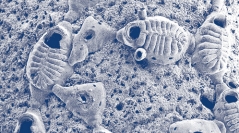On slopes of the bathyal zone, branched scleractinian corals produce three-dimensional constructions and rubble which provide hard substrates particularly suitable for encrusting bryozoans. Samples of “cold water corals”, mainly Madrepora oculata Linnaeus, 1758, collected on six seamounts of the South Azorean Seamount Chain (SASC), allowed a close re-examination of a poorly-known uniserial encrusting cheilostome bryozoan, Harmelinius uniserialis (Harmelin, 1978), revealing unexpected morphological features. In contradistinction to the apparent simplicity of its colony shape formed by ramifying chains of autozooids and vicarious kenozooids, this species presents a great structural complexity shaped by different types of polymorphs. The vicarious kenozooids are the basis of a disparity cline including the distal kenozooidal part of ovicelled and non-ovicelled autozooids, and five differently-shaped adventitious avicularia, which is validated by a puzzling morphological trait (tiny porous knobs) shared by most of them. The common origin of kenozooids and avicularia represents an innovation among cheilostome bryozoans, apparently with little or hidden evolutionary development. The functions of these polymorphs are unclear except for a role as connecting tools and ooecial cover of kenozooids integrated with autozooids. Vicarious kenozooids are assumed to store metabolites in their large chamber and to dispatch them through the mesenchymatous network. The different types of avicularia, budded by the same colony and even by the same autozooid, might have a common role of water renewal at the colony surface, improving the supply of particulate food. The high frequency of processes of zooid repair by intramural budding and still living fragments of colony, the thickness of walls and the great rarity of both ovicells and ancestrulae indicate that colonies are particularly long-lived and have a very low reproduction rate. These features and the confinement of colonies within the boundary layer of substrates result in very limited larval dispersal and the endemism of this species to the 600-1500 m depth zone of the South Azorean Seamount Chain and the southern bathyal slope of the Azores. Several traits of H. uniserialis suggest that it may be a relict species.


 Zoosystema
46 (30) - Pages 749-774
Zoosystema
46 (30) - Pages 749-774